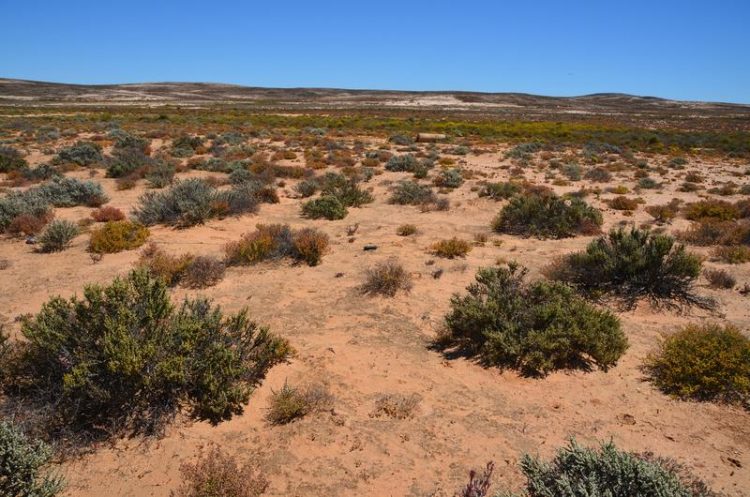Biological soil crusts endangered by global change

Biological soil crusts form a fundamental part of the vegetation in the semi-desert of South Africa’s Succulent Karoo. Bettina Weber
Biological soil crusts protect the soil, accelerate the rate of soil formation and contribute to biogeochemical nutrient cycling via fixation of atmospheric carbon (C) and nitrogen (N). Although, visually, they are among the least impressive communities in nature, they form a vital part of natural cycles.
Together with international colleagues, scientists from the Max Planck Institute for Chemistry have now created a world map showing the occurrence of biological soil crusts. With the help of this map and predictions on the impact of global change, the scientists conclude that 25 to 40 percent of the world’s soil crusts will have disappeared by 2070. The journal Nature Geosciences reports on the study in its march issue.
“Biological soil crusts (biocrusts) consist of communities of cyanobacteria, algae, lichens and bryophytes. The layers are only few millimeters thick, forming encrustations on the soil surface of drylands, which stabilize the soil and prevent erosion,” explains Bettina Weber, Research Group Leader at the MPI for Chemistry in Mainz. She has been studying these remarkable communities for many years. Together with her colleagues, the biologist evaluated over 500 publications on the topic of biocrusts to create the first global distribution map. They discovered that biological soil crusts currently cover about twelve percent of the Earth’s surface.
Biocrusts are particularly prevalent in desert and savanna areas, such as in southern Africa, Australia, and Asia as well as across the south-western USA. In temperate latitudes across Central Europe, vascular plants such as trees and shrubs are dominant.
“The occurrence of biocrusts mainly depends on the interaction of precipitation, temperature and agricultural land use,” explains Emilio Rodriguez-Caballero, a former postdoc in Bettina Weber’s working group, who is now doing research at the University of Almeria.
To establish the soil crust map, the Spaniard used 18 different environmental parameters, which determine how suitable an area of land is to the growth of biocrusts. The parameters include climatic factors such as temperature and precipitation, soil properties such as mineral content, agricultural use, and the topography of the landscape.
Not only did the researchers create a global map of soil crusts. Based on various future scenarios, they calculated how the soil crust cover is likely to be affected by global change.
Such emission scenarios were developed by the Intergovernmental Panel on Climate Change (IPCC) and indicate how the Earth will change in terms of climate and land use compared to pre-industrial times. They range from the assumption that global warming will remain less than two degrees Celsius thanks to a massive reduction in emissions, to an extreme scenario in which greenhouse gas emissions and land use continue to increase as before. The latter, sometimes called the business-as-usual scenario, predicts that on average the Earth’s surface will warm up by more than four degrees Celsius compared to pre-industrial times.
Global change: more than a quarter of biocrust surfaces are expected to disappear
Regardless of which scenario the Earth is heading for, the predicted decline in biological soil crusts is between 25 and 40 percent. This means that even in the case of moderate global change, the biocrust cover is expected to decrease by one quarter. This decline is caused not only by rising temperatures and altered precipitation patterns but also by agriculture. Bettina Weber’s team expects land use pressure to increase in many semi-arid regions, such as Asia and southern Africa in the coming decades as a result of climate change and a growing world population.
The climate- and landuse-triggered decline in biocrusts could also have a significant impact on biogeochemical cycles such as those of nitrogen and carbon. In earlier studies, Bettina Weber and her colleagues showed that the tiny organisms that make up biocrusts may be responsible for around half of all biological nitrogen fixation that takes place on the Earth’s surface. This is important for the development of ecosystems, as nitrogen is often the limiting nutrient (source: Nature Geoscience, June 3, 2012, DOI: 10.1038 / NGEO1486 and PNAS, DOI: 10.1073 / pnas.1515818112) and improves soil fertility, especially in nutrient-poor ecosystems.
In addition, the large-scale decline in biocrusts would probably also affect our health. “As biocrusts play a key role in soil stabilization, the widespread decline will likely cause a significant increase in exposure to airborne dust and dust storms − with significant effects on human health and the environment,” says Ulrich Pöschl, Director at the Max Planck Institute for Chemistry. From the researchers’ point of view, it is therefore important to consider the occurrence and cover of biological soil crusts in climate and Earth system models.
http://DOI: 10.1038/s41561-018-0072-1
Media Contact
More Information:
http://www.mpic.de/All latest news from the category: Earth Sciences
Earth Sciences (also referred to as Geosciences), which deals with basic issues surrounding our planet, plays a vital role in the area of energy and raw materials supply.
Earth Sciences comprises subjects such as geology, geography, geological informatics, paleontology, mineralogy, petrography, crystallography, geophysics, geodesy, glaciology, cartography, photogrammetry, meteorology and seismology, early-warning systems, earthquake research and polar research.
Newest articles

Silicon Carbide Innovation Alliance to drive industrial-scale semiconductor work
Known for its ability to withstand extreme environments and high voltages, silicon carbide (SiC) is a semiconducting material made up of silicon and carbon atoms arranged into crystals that is…

New SPECT/CT technique shows impressive biomarker identification
…offers increased access for prostate cancer patients. A novel SPECT/CT acquisition method can accurately detect radiopharmaceutical biodistribution in a convenient manner for prostate cancer patients, opening the door for more…

How 3D printers can give robots a soft touch
Soft skin coverings and touch sensors have emerged as a promising feature for robots that are both safer and more intuitive for human interaction, but they are expensive and difficult…




















